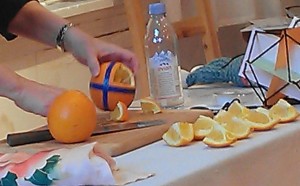Laban visualized movement space as a spherical orb surrounding the body, which he called the “kinesphere.” He then went on to create a virtual geography for this spherical space, using lines, planes, and regular polyhedra — notably the octahedron, cube, and icosahedron.
Laban’s imaginary geography is quite practical. Nevertheless, imagination fails many students when they have to visualize their own bodies surrounded by geometrical figures.
During the Meaning in Motion lecture last month in New York City, I demonstrated one technique I have used to make Laban’s geometry of the kinesphere concrete. Using a couple of oranges, knives, a chopping board, and a bamboo skewer, I showed how the cardinal planes divide the kinesphere into eight movement zones, and how these zones relate to the cubic diagonals and the polar triangles of the icosahedron.
 The first part of the demonstration illustrates how the cardinal planes divide the kinesphere. To show how the horizontal plane bifurcates the orb of personal space, I chop the orange in half, separating the top and bottom. To show the vertical plane, I chop the orange again, separating front from back. With a bit of manual dexterity, I can slice the rapidly-coming-apart orange one more time, separating the right and left sides, as the sagittal plane does. At this point, the orange falls apart into eight identical pieces. Oui la – the eight zones of the kinesphere!
The first part of the demonstration illustrates how the cardinal planes divide the kinesphere. To show how the horizontal plane bifurcates the orb of personal space, I chop the orange in half, separating the top and bottom. To show the vertical plane, I chop the orange again, separating front from back. With a bit of manual dexterity, I can slice the rapidly-coming-apart orange one more time, separating the right and left sides, as the sagittal plane does. At this point, the orange falls apart into eight identical pieces. Oui la – the eight zones of the kinesphere!
My second orange is circled with colored tape to indicate the edges of the three planes. This shows that there are four upper zones and four lower zones. First I carve out the roughly triangular upper zone that is to the right and on the front surface of the orange. Then I carve out the opposite lower zone that is to the left and on the back of the orange. I run the bamboo skewer diagonally through the center of the orange, connecting the zone around right, forward, high with the zone around left, back, low.
This demonstration not only helps students see how the planes, cubic diagonals, and polar triangles relate to the globe-shaped kinesphere, but also entitles me to be known as the “Julia Child of Laban Movement Analysis.” Perhaps a cooking show will be next!
